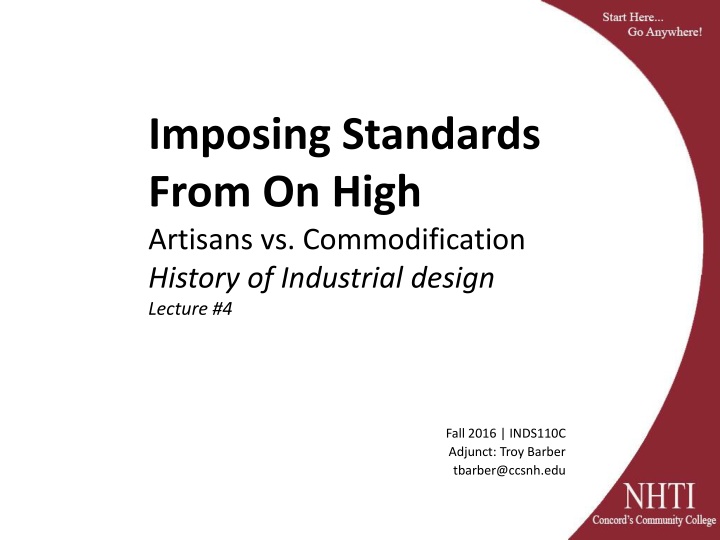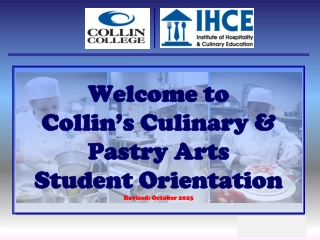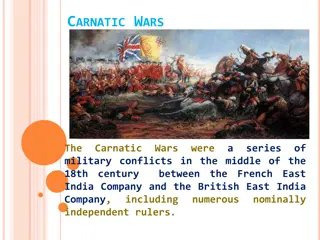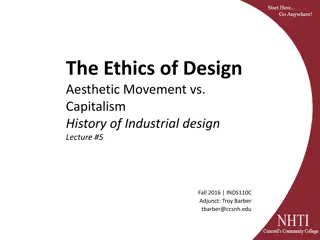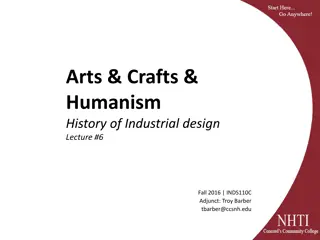Evolution of Design Reform: Influence on British Arts and Industry
British arts faced challenges in the 19th century due to lack of encouragement, resulting in increased foreign imports. Influential figures like Sir Henry Cole and A.W.N. Pugin advocated for design education and emphasized the importance of form and function in industrial design. The Design Reform Movement aimed to elevate public taste by bridging fine art with manufacturing, as showcased in the Great Exhibition of 1851.
Download Presentation

Please find below an Image/Link to download the presentation.
The content on the website is provided AS IS for your information and personal use only. It may not be sold, licensed, or shared on other websites without obtaining consent from the author.If you encounter any issues during the download, it is possible that the publisher has removed the file from their server.
You are allowed to download the files provided on this website for personal or commercial use, subject to the condition that they are used lawfully. All files are the property of their respective owners.
The content on the website is provided AS IS for your information and personal use only. It may not be sold, licensed, or shared on other websites without obtaining consent from the author.
E N D
Presentation Transcript
Imposing Standards From On High Artisans vs. Commodification History of Industrial design Lecture #4 Fall 2016 | INDS110C Adjunct: Troy Barber tbarber@ccsnh.edu
Arts in Britain had received very little encouragement and that the result was both a decline in demand abroad and in increase in foreign imports at home. Arts of painting and sculpture should form the basis for the education of designers in manufactures to elevate the general standards of public taste. House Report of 1835-6
Three Design Principals of the Design Reform Movement 1. Decoration is secondary to form 2. Form is dictated by function and the materials 3. Design should derive from historical English and non- Western ornament as well as plan and animal sources
Sir Henry Cole (1808-1882) Design Reform Movement House Report of 1835-6 Organized Great Exhibition of 1851 Advocate for Design Education Designer of pottery, Xmas cards, etc. An alliance between fine art and manufacturers would promote public taste. But also elevate British goods in expanding world trade
Sir Henry Cole (1808-1882) Design Reform Movement..continued
Great Exhibition of 1851 A.k.a. Crystal Palace Exhibition Hyde Park, London May 1 Oct. 11 1851 First in a series of World s Fairs Exhibited all the world s culture & industry Supported by Prince Albert, Queen Victoria s Consort Highlighting Britain s Superiority Came after 2 decades of political & social upheaval 6M people Britain s population was then 18M(!) visited the Great Exhibition. The event made a surplus of 186,000 ( 18,370,000 in 2015 pounds)
A.W.N. Pugin (1812-1852) Design Reform Movement Design goods are merely embellishments of architecture and should be subordinated to, rather than independent from, the structure. Example: statues on a column, even with stylized figures, maintain their structure as columns. Respect for materials, e.g. carved wood should not look like it s molded. Form Is Function
Richard Redgrave (1804- 1888) Design Reform Movement
Horatio Greenough (1805- 1852) Design Reform Movement American Neo-Classical sculptor Beauty in architecture and design was a result of fitness to function Earliest statements in support of what would later be known as the doctrine of Functionalism The design of an object should be determined solely by its function, rather than by aesthetic considerations, and that anything practically designed will be inherently beautiful.
John Ruskin (1819-1900) Design Reform Movement English Art Critic 1850-1870 s Oxford Professor of Fine Art, 1869 Author of The Stones of Venice The imperfect execution of ornament was an index of social conditions in which workers had freedom and dignity. Aesthetics are a byproduct of the conditions of labor. Gave rise to the Arts and Crafts movement. "The art of any country is the exponent of its social and political virtues."
Owen Jones (1809-1874) Design Reform Movement Welsh architect & designer Influential color theorist Focused on flat patterning & ornament ..Architecture is progressive, and must keep pace with the development of the wants, the faculties, and sentiments of mankind. True art [consists of] idealizing, and not copying, the forms of nature.
Karl Marx (1818-1883) The Communist Manifesto Philosopher, economist, sociologist, journalist, and revolutionary socialist. Originally Prussian, lived in England from 1849 until his death. Human societies develop through class struggle Conflict arises between the ruling classes the bourgeoisie that control the means of production and the working classes known as the proletariat that work on these means by selling their labor for wages. Marx s theories of alienation, value, commodity fetishism, and surplus value argued that capitalism facilitated social relations and ideology through commodification, in equality, and the exploitation of labor.
Charles Eastlake (1836- 1906) Hints on Household Taste British architect & furniture designer Principal advocate of the revived Early English or Modern Gothic style Did not make any furniture; his designs were produced by professional cabinet makers Furniture and decor in the home should be handmade or at least manufactured by machine workers who injected a love and pride into their creations. Eastlake was a believer in straight lines and designs inspired by 'country work', often executed in oak and similar fruitwoods. Encouraged honesty in production, construction, and finishing of any particular piece Calling for rectangular joinery and hand crafted, solid wood furniture. He advocated a furnishing style in which a single influence dominated the fittings and furnishings of a home.
Why do people proselytize? Complicated question Why argue that public museums should serve the interests of the working class and be the antidote to brutality and vice ? Was it actually all about control of the masses? Prevention of revolution? Design Standards Why?
Grant Information Get IT is sponsored by a $2.5 million grant from the U.S. Department of Labor, Employment & Training Administration TAACCCT Grant #TC-26498-14-60-A-33 NHTI, Concord s Community College, is an equal opportunity employer, and adaptive equipment is available upon request to persons with disabilities. This workforce solution was funded by a grant awarded by the U.S. Department of Labor s Employment and Training Administration. The solution was created by the grantee and does not necessarily reflect the official position of the U.S. Department of Labor. The Department of Labor makes no guarantees, warranties, or assurances of any kind, express or implied, with respect to such information, including any information on linked sites, and including, but not limited to accuracy of the information or its completeness, timeliness, usefulness, adequacy, continued availability or ownership.
NHTI information and Attribution NHTI, Concord s Community College 31 College Drive Concord, NH 03301 www.nhti.edu Creative Commons Attribution 4.0 International License INDS 110C History of Design curriculum by Troy Barber is licensed under the Creative Commons Attribution 4.0 International License. To view a copy of this license visit http://creativecommons.org/licenses/by/4.0/deed.en_US. http://creativecommons.org/licenses/by/4.0/deed.en_US
